Study on the Binding Behavior of Chloride Ion and Ettringite in Nano-Metakaolin Cement by Seawater Mixing and Curing Temperatures
Abstract
1. Introduction
2. Experimental Section
2.1. Raw Materials
2.2. Specimen-Matching Ratio and Production
2.2.1. Mix Ratio of Specimens
2.2.2. Specimen Preparation Process
2.3. Test Methods
2.3.1. XRD
2.3.2. Thermogravimetric Analysis (TG)
2.3.3. Scanning Electron Microscope (SEM)
2.3.4. Mercury-Intrusion Porosimetry (MIP)
3. Results and Discussion
3.1. Effect of Chloride Concentration on Friedel’s Salt and AFt
3.2. Effect of Curing Temperature on AFt and Friedel’s Salt
3.3. Effect of Nano-Metakaolin Content on AFt and Friedel’s Salt
4. Conclusions
- (1)
- With the increase of chloride content, Friedel’s salt and AFt production increased. The amount of Friedel’s salt produced in samples with 1% and 2% chloride ion concen-trations was 2.8 × 10−2 mg/g and 3.9 × 10−2 mg/g at 3 days, and 4.6 × 10−2 mg/g and 9.7 × 10−2 mg/g at 28 days. At 28 days, delayed AFt production increased by 26.29% and 27.95%, and the length and diameter of ettringite crystals increased. After adding chlorine salt, the porosity of the cement paste was reduced, and the pore size was refined. The denser the pore structure, the greater the internal force caused by delayed AFt, which increases the probability of cement base cracking and adversely affects durability.
- (2)
- Increasing curing temperature can increase the amount of Friedel’s salt and decrease the amount of delayed AFt. After 28 days of high-temperature curing, Friedel’s salt production increased by 13.04%, delayed AFt production decreased by 9.68%, and the length and diameter of the ettringite crystal decreased. Increasing the curing temperature also reduces the porosity of the cement paste and refines the pore size. On the one hand, increasing curing temperature can increase the amount of chlorine-separation bonding. On the other hand, it can reduce the adverse effects of delayed AFt.
- (3)
- The addition of nano-metakaolin can increase the amount of Friedel’s salt and decrease the amount of delayed AFt. When 5% nano-metakaolin was added at 28 days, Friedel’s salt production increased by 14.34%, ettringite production decreased by 7.93%, and the length and diameter of AFt crystals decreased. Adding nano-metakaolin can reduce the formation of delayed AFt and reduce the harm of delayed AFt.
- (4)
- Increasing the curing temperature and adding nano-metakaolin can mitigate the adverse effects of delayed AFt. The effect of seawater mixing on cement hydration reaction is complex. In this paper, only the effect of chloride ions in seawater on the hydration reaction of cement is studied, and the effect of other ions in seawater is ignored. Some factors such as the existence of a certain number of magazines affect the performance of nano-metakaolin. Therefore, more research is needed to understand the effect of seawater on cement hydration and the application of nano-metakaolin in cement-based materials.
Author Contributions
Funding
Institutional Review Board Statement
Informed Consent Statement
Data Availability Statement
Acknowledgments
Conflicts of Interest
References
- Xiao, J.; Qiang, C.; Nanni, A.; Zhang, K. Use of sea-sand and seawater in concrete construction: Current status and future opportunities. Constr. Build. Mater. 2017, 155, 1101–1111. [Google Scholar] [CrossRef]
- Teymouri, M.; Shakouri, M. Chloride desorption mechanisms of cement pastes containing fly ash. Constr. Build. Mater. 2023, 370, 130667. [Google Scholar] [CrossRef]
- Li, Y.; Zhao, X.; Raman, R.S. Durability of seawater and sea sand concrete and seawater and sea sand concrete-filled fibre-reinforced polymer/stainless steel tubular stub columns. Adv. Struct. Eng. 2021, 24, 1074–1089. [Google Scholar] [CrossRef]
- Wang, X.; Shi, J.; Ding, L.; Jin, Y.; Wu, Z. Durability of coral-reef-sand concrete beams reinforced with basalt fibre-reinforced polymer bars in seawater. Adv. Struct. Eng. 2021, 24, 1235–1247. [Google Scholar]
- Ahmed, A.; Guo, S.; Zhang, Z.; Shi, C.; Zhu, D. A review on durability of fiber reinforced polymer (FRP) bars reinforced seawater sea sand concrete. Constr. Build. Mater. 2020, 256, 119484. [Google Scholar] [CrossRef]
- Saleh, S.; Mahmood, A.H.; Hamed, E.; Zhao, X. The mechanical, transport and chloride binding characteristics of ultra-high-performance concrete utilising seawater, sea sand and SCMs. Constr. Build. Mater. 2023, 372, 130815. [Google Scholar] [CrossRef]
- Yuan, Q.; Shi, C.; Schutter, G.D. Chloride binding of cement-based materials subjected to external chloride environment—A review. Constr. Build. Mater. 2009, 23, 1–13. [Google Scholar] [CrossRef]
- Cai, Y.; Xuan, D.; Poon, C.S. Influence of availability of calcium on the hydration of tricalcium aluminate (C3A) in seawater mixed C3A-gypsum system. J. Am. Ceram. Soc. 2022, 105, 5895–5910. [Google Scholar] [CrossRef]
- Li, P.; Li, W.; Yu, T.; Qu, F.; Tam, V.W.Y. Investigation on early-age hydration, mechanical properties and microstructure of seawater sea sand cement mortar. Constr. Build. Mater. 2020, 249, 118776. [Google Scholar] [CrossRef]
- Elakneswaran, Y.; Nawa, T.; Kurumisawa, K. Electrokinetic potential of hydrated cement in relation to adsorption of chlorides. Cem. Concr. Res. 2009, 39, 340–344. [Google Scholar] [CrossRef]
- Zhang, T.; Tan, H.; Ni, J.; Ma, B.; Liu, X.; Chen, P.; Shi, T. Effect of barium ion on the stability and chloride ion binding of ettringite. J. Build. Eng. 2023, 79, 107803. [Google Scholar] [CrossRef]
- Sui, S.; Wilson, W.; Georget, F.; Maraghechi, H.; Kazemi-Kamyab, H.; Sun, W.; Karen, S. Quantification methods for chloride binding in Portland cement and limestone systems. Cem. Concr. Res. 2019, 125, 105864. [Google Scholar] [CrossRef]
- Shi, Z.; Geiker, M.R.; Lothenbach, B.; Weerdt, K.D.; Garzón, S.F.; Enemark-Rasmussen, K.; Skibsted, J. Friedel’s salt profiles from thermogravimetric analysis and thermodynamic modelling of Portland cement-based mortars exposed to sodium chloride solution. Cem. Concr. Compos. 2017, 78, 73–83. [Google Scholar] [CrossRef]
- Bentz, D.P.; Garboczi, E.J.; Lu, Y.; Martys, N.; Sakulich, A.R.; Weiss, W.J. Modeling of the influence of transverse cracking on chloride penetration into concrete. Cem. Concr. Compos. 2013, 38, 65–74. [Google Scholar] [CrossRef]
- Wang, Y.; Shui, Z.; Gao, X.; Huang, Y.; Yu, R.; Song, Q. Chloride binding capacity and phase modification of alumina compound blended cement paste under chloride attack. Cem. Concr. Compos. 2020, 108, 103537. [Google Scholar] [CrossRef]
- Tang, L. Engineering expression of the Clin Conc model for prediction of free and total chloride ingress in submerged marine concrete. Cem. Concr. Res. 2008, 38, 1092–1097. [Google Scholar]
- Baroghel-Bouny, V.; Thiery, M.; Wang, X. Modelling of isothermal coupled moisture-ion transport in cementitious materials. Cem. Concr. Res. 2011, 41, 828–841. [Google Scholar] [CrossRef]
- Florea, M.; Brouwers, H. Chloride binding related to hydration products. Cem. Concr. Res. 2012, 42, 282–290. [Google Scholar] [CrossRef]
- Li, Q.; Fan, Y.; Qi, Y.; Zhang, S.; Shah, S.P. Effect of nano-metakaolin on the chloride diffusion resistance of cement mortar with addition of fly ash. J. Build. Eng. 2024, 88, 109171. [Google Scholar] [CrossRef]
- Farnam, Y.; Dick, S.; Wiese, A.; Davis, J.; Bentz, D.; Weiss, J. The influence of calcium chloride deicing salt on phase changes and damage development in cementitious materials. Cem. Concr. Compos. 2015, 64, 1–15. [Google Scholar] [CrossRef] [PubMed]
- Sun, Y.; Zhang, Y.; Cai, Y.; Lam, W.L.; Lu, J.X.; Shen, P.; Poon, C.S. Mechanisms on accelerating hydration of alite mixed with inorganic salts in seawater and characteristics of hydration products. ACS Sustain. Chem. Eng. 2021, 9, 10479–10490. [Google Scholar] [CrossRef]
- Thomas, M.D.A.; Hooton, R.; Scott, A.; Zibara, H. The effect of supplementary cementitious materials on chloride binding in hardened cement paste. Cem. Concr. Res. 2012, 42, 1–7. [Google Scholar] [CrossRef]
- Matschei, T.; Lothenbach, B.; Glasser, F. The AFm phase in Portland cement. Cem. Concr. Res. 2007, 37, 118–130. [Google Scholar] [CrossRef]
- Hargis, C.W.; Kirchheim, A.P.; Monteiro, P.J.; Gartner, E.M. Early age hydration of calcium sulfoaluminate (synthetic ye’elimite, C4A3S) in the presence of gypsum and varying amounts of calcium hydroxide. Cem. Concr. Res. 2013, 48, 105–115. [Google Scholar] [CrossRef]
- Cai, Y.; Tao, Y.; Xuan, D.; Zhu, X.; Poon, C.S. Effects of seawater on the formation and mechanical properties of Friedel’s salt associated with tricalcium aluminate. Cem. Concr. Res. 2023, 174, 7034. [Google Scholar] [CrossRef]
- Balonis, M.; Lothenbach, B.; Saout, G.L.; Glasser, F.P. Impact of chloride on the mineralogy of hydrated Portland cement systems. Cem. Concr. Res. 2010, 40, 1009–1022. [Google Scholar] [CrossRef]
- Althoey, F. Compressive strength reduction of cement pastes exposed to sodium chloride solutions: Secondary ettringite formation. Constr. Build. Mater. 2021, 299, 123965. [Google Scholar] [CrossRef]
- Taylor, H.F.W.; Famy, C.; Scrivener, K.L. Delayed ettringite formation. Cem. Concr. Res. 2001, 31, 683–693. [Google Scholar] [CrossRef]
- Collepardi, M. A state-of-the-art review on delayed ettringite attack on concrete. Cem. Concr. Compos. 2003, 25, 401–407. [Google Scholar] [CrossRef]
- Pavoine, A.; Brunetaud, X.; Divet, L. The impact of cement parameters on Delayed Ettringite Formation. Cem. Concr. Compos. 2012, 34, 521–528. [Google Scholar] [CrossRef]
- Pichelin, A.; Carcassès, M.; Cassagnabère, F.; Multon, S.; Nahas, G. Sustainability, transfer and containment properties of concrete subject to delayed ettringite formation (DEF). Cem. Concr. Compos. 2020, 113, 103738. [Google Scholar] [CrossRef]
- Nguyen, V.H.; Leklou, N.; Aubert, J.E.; Mounanga, P. The effect of natural pozzolan on delayed ettringite formation of the heat-cured mortars. Constr. Build. Mater. 2013, 48, 479–484. [Google Scholar] [CrossRef]
- Wang, C.; Jin, Z.; Li, J.; Dong, W.; Chen, R.; Yang, Y.; Chen, Y.; Wang, D.; Pang, B. Experimental study on early shrinkage and later expansion of concrete under a simulated geothermal environment. J. Build. Eng. 2023, 72, 106493. [Google Scholar] [CrossRef]
- Tosun, K.; Baradan, B. Effect of ettringite morphology on DEF-related expansion. Cem. Concr. Compos. 2010, 32, 271–280. [Google Scholar] [CrossRef]
- Zhang, S.; Fan, Y.; Huang, J.; Shah, S.P. Effect of nano-metakaolinite clay on the performance of cement-based materials at early curing age. Constr. Build. Mater. 2021, 291, 123107. [Google Scholar] [CrossRef]
- Sujak, A.; Pyzalski, M.; Durczak, K.; Brylewski, T.; Murzyn, P.; Pilarski, K. Studies on Cement Pastes Exposed to Water and Solutions of Biological Waste. Materials 2022, 15, 1931. [Google Scholar] [CrossRef] [PubMed]
- Durczak, K.; Pyzalski, M.; Pilarski, K.; Brylewski, T.; Sujak, A. The Effect of Liquid Slurry-Enhanced Corrosion on the Phase Composition of Selected Portland Cement Pastes. Materials 2021, 14, 1707. [Google Scholar] [CrossRef]
- Villagrán-Zaccardi, Y.A.; Egüez-Alava, H.; Buysser, K.D.; Gruyaert, E.; Belie, N.D. Calibrated quantitative thermogravimetric analysis for the determination of portlandite and calcite content in hydrated cementitious systems. Mater. Struct. 2017, 50, 179. [Google Scholar] [CrossRef]
- Pang, B.; Zhou, Z.; Xu, H. Utilization of carbonated and granulated steel slag aggregate in concrete. Constr. Build. Mater. 2015, 84, 454–467. [Google Scholar] [CrossRef]
- Long, W.; Zhang, X.; Feng, G.; Xie, J.; Xing, F.; Dong, B.; Zhang, J.; Khayat, K.H. Investigation on chloride binding capacity and stability of Friedel’s salt in graphene oxide reinforced cement paste. Cem. Concr. Compos. 2022, 132, 104603. [Google Scholar] [CrossRef]
- Qiao, C.; Suraneni, P. Chloride binding of cement pastes with fly ash exposed to CaCl2 solutions at 5 and 23 °C. Cem. Concr. Compos. 2019, 97, 43–53. [Google Scholar] [CrossRef]
- Luo, X.; Li, S.; Guo, Z.; Liu, C.; Gao, J. Effect of curing temperature on the hydration property and microstructure of Portland cement blended with recycled brick powder. J. Build. Eng. 2022, 61, 105327. [Google Scholar] [CrossRef]
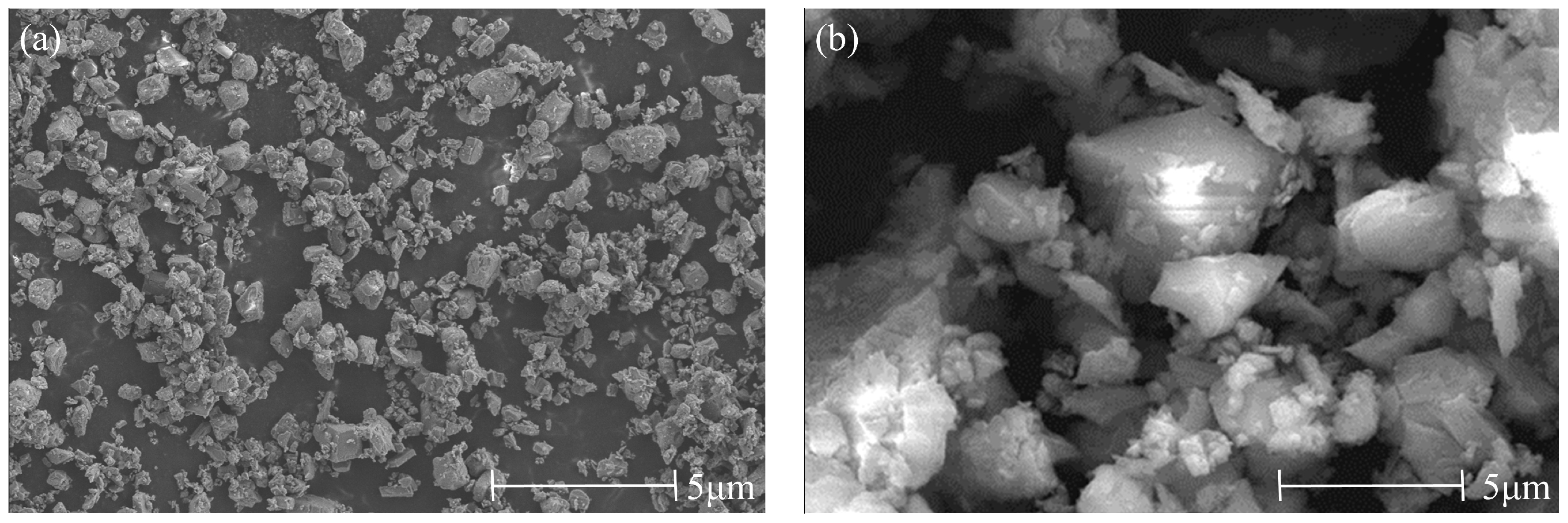
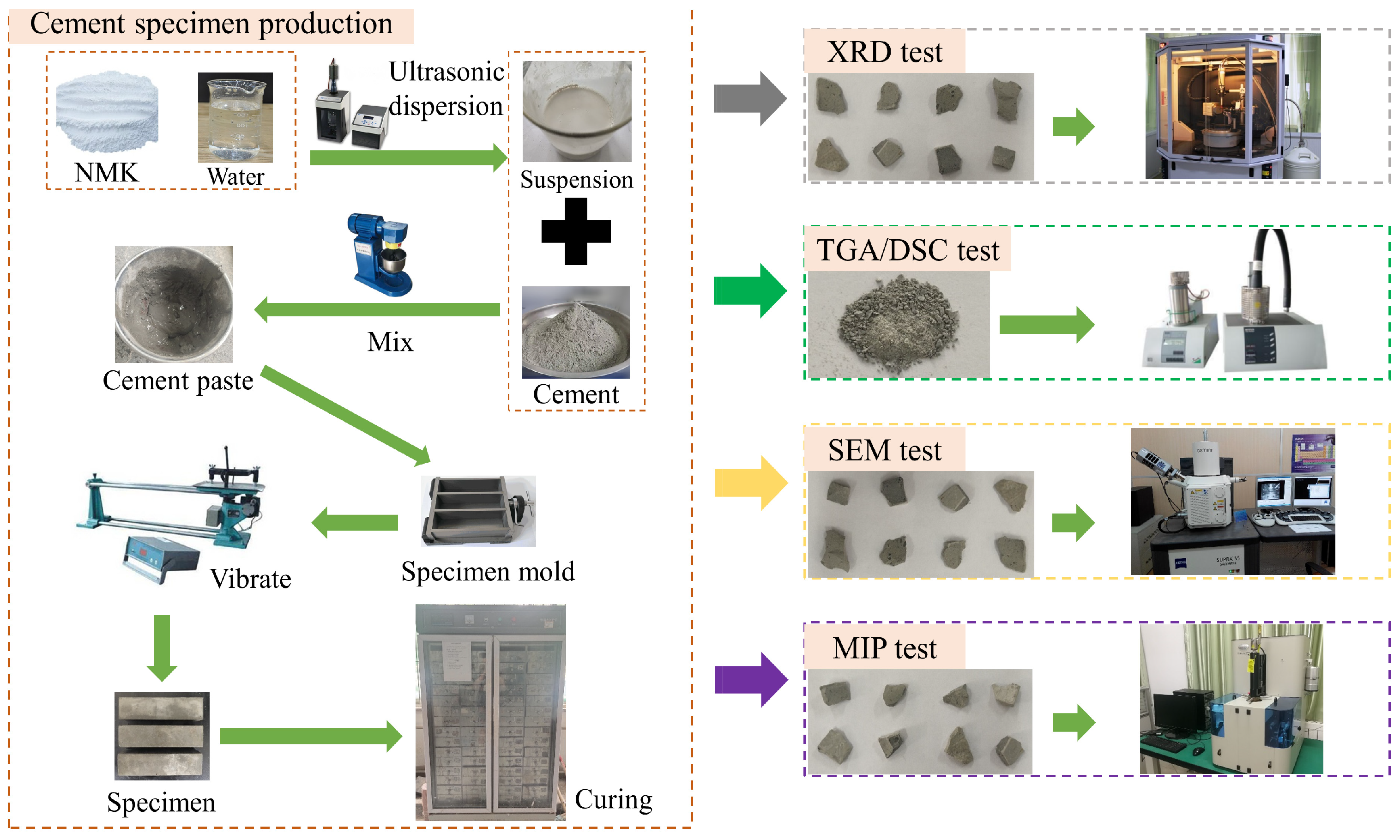
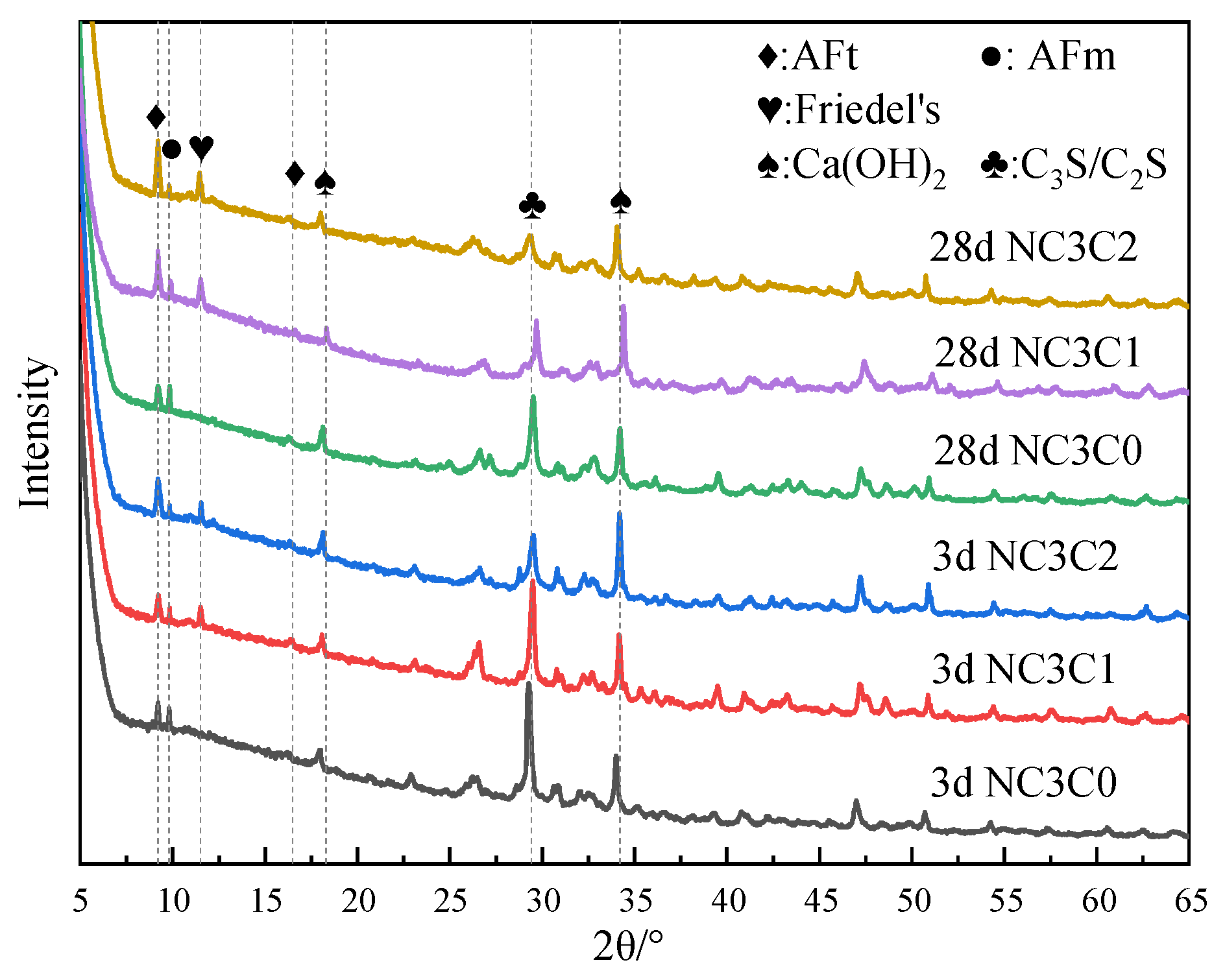
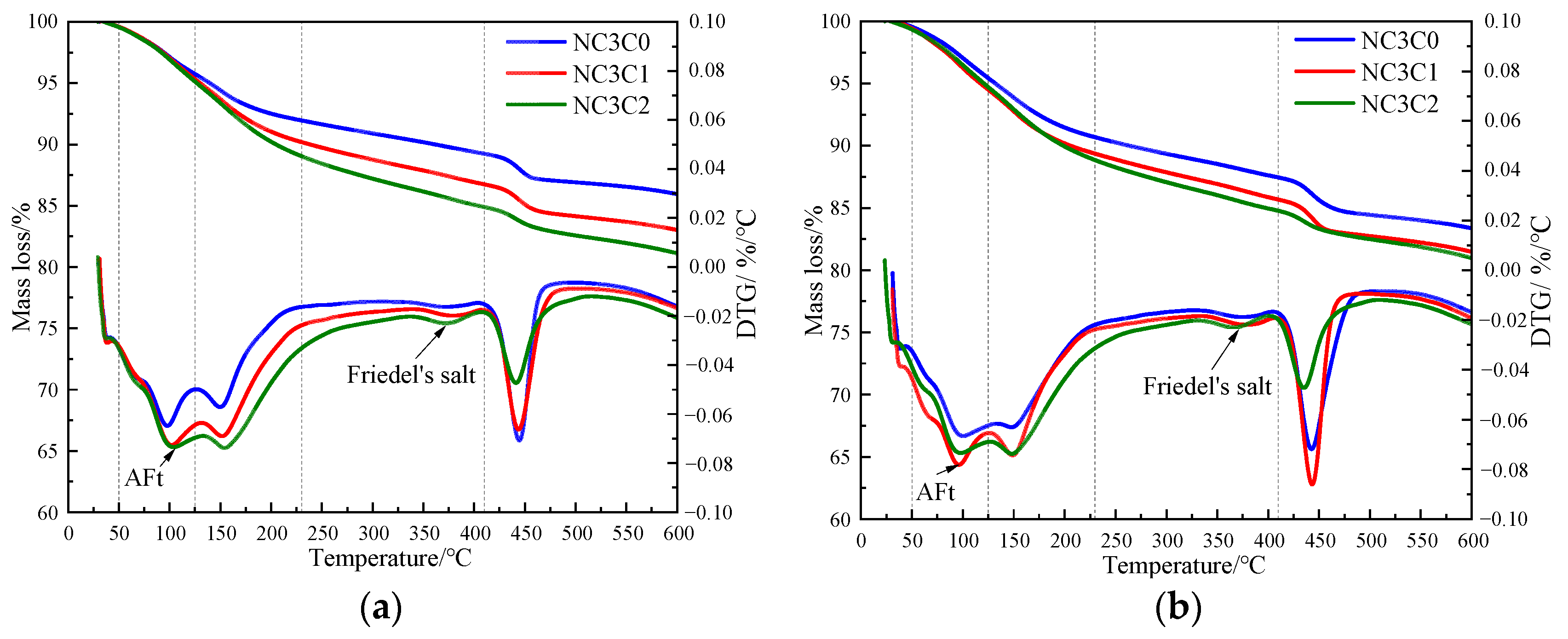



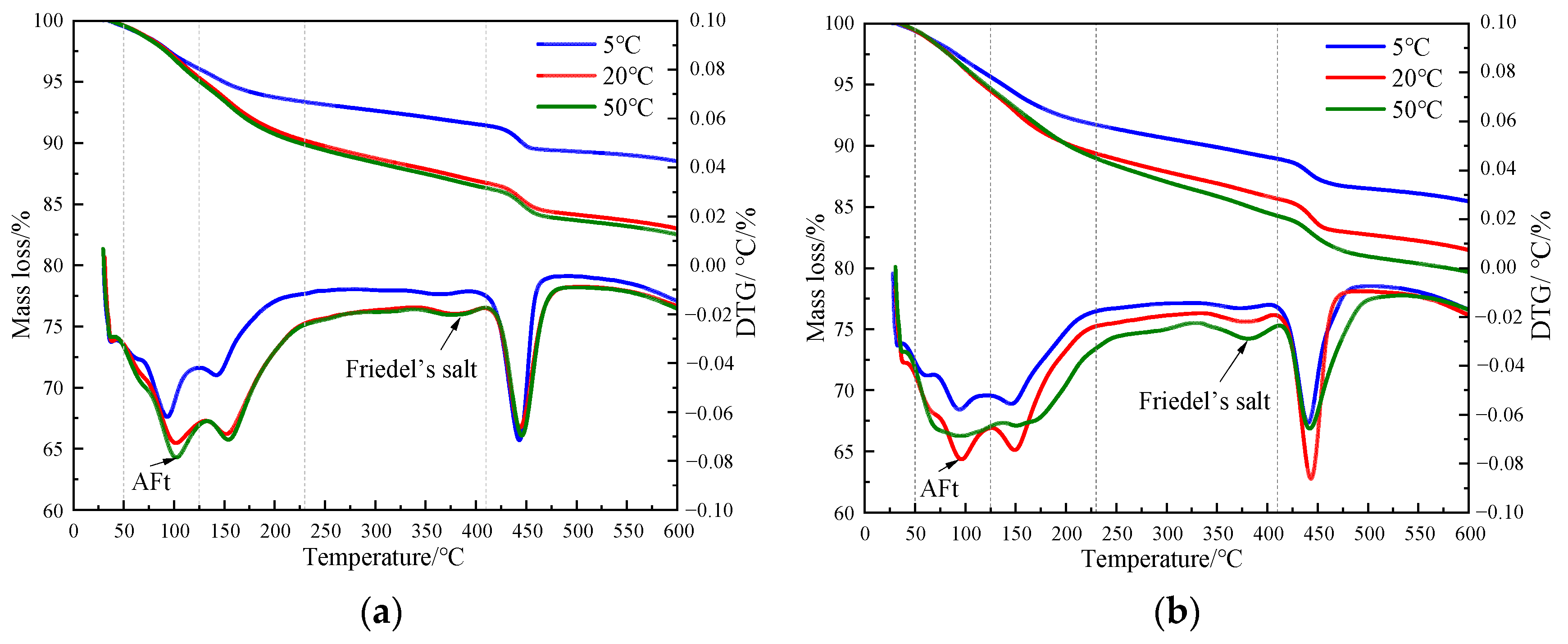




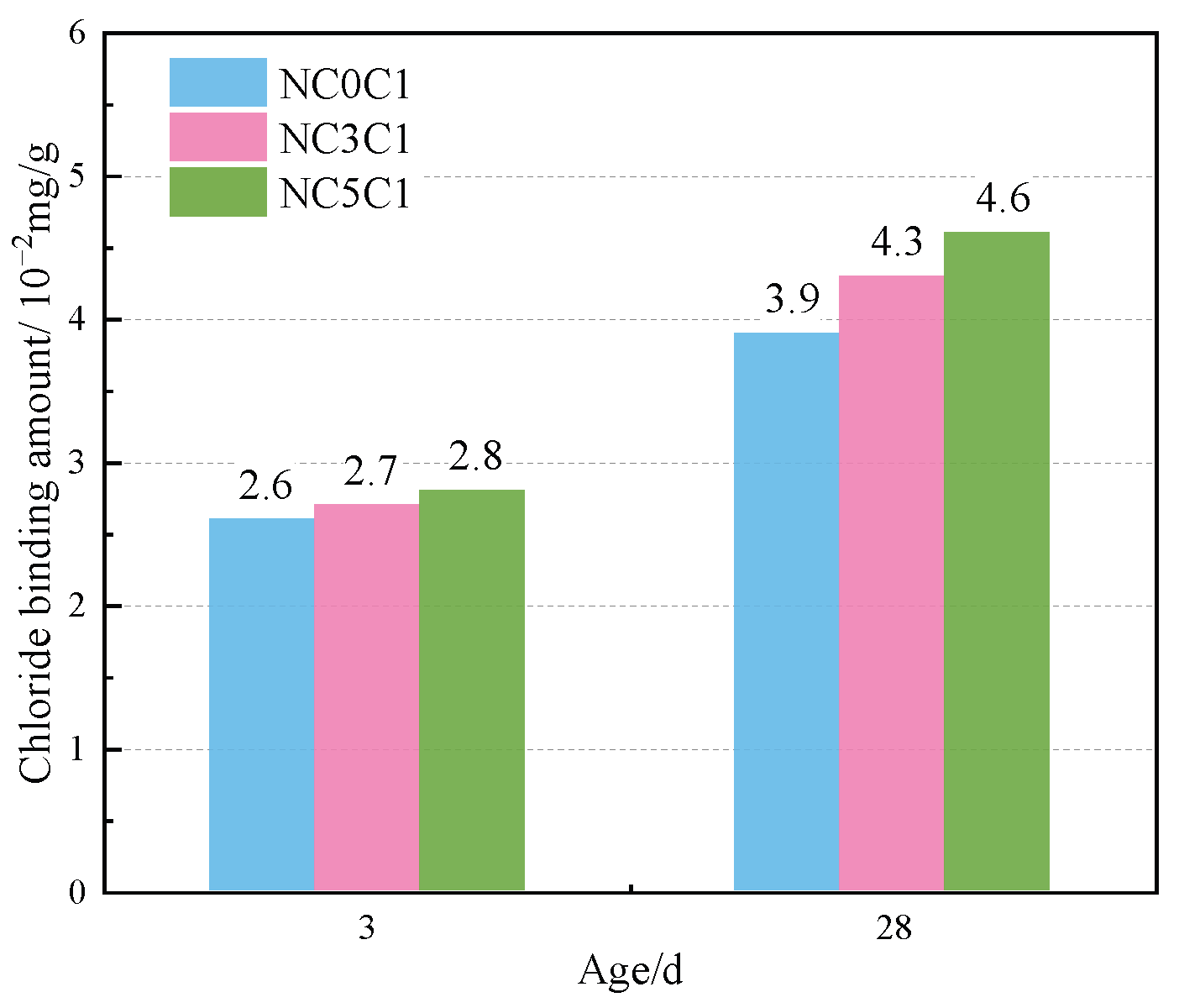

| Oxide (wt.%) | CaO | SiO2 | Al2O3 | Fe2O3 | MgO | Other |
|---|---|---|---|---|---|---|
| Cement | 59.31 | 21.90 | 6.26 | 3.79 | 1.63 | 7.11 |
| NMK | 0.10 | 46.82 | 50.46 | 0.44 | 0.13 | 2.05 |
| Sample | Cement/g | NMK/g | Water/g | Chloride Ion Concentrations/% |
|---|---|---|---|---|
| NC3C0 | 485 | 15 | 200 | 0 |
| NC3C1 | 485 | 15 | 200 | 1 |
| NC3C2 | 485 | 15 | 200 | 2 |
| NC0C1 | 500 | 0 | 200 | 1 |
| NC5C1 | 475 | 25 | 200 | 1 |
| Sample | Porosity/% | Average Pore Size/nm | Median Pore Size/nm | Most Probable Pore Size/nm |
|---|---|---|---|---|
| 3 days NC3C0 | 33.07 | 27.50 | 59.74 | 62.51 |
| 3 days NC3C1 | 32.45 | 22.90 | 43.58 | 55.74 |
| 3 days NC3C2 | 31.72 | 23.43 | 45.80 | 55.76 |
| 28 days NC3C0 | 30.88 | 22.31 | 41.12 | 62.48 |
| 28 days NC3C1 | 27.29 | 20.02 | 31.81 | 55.75 |
| 28 days NC3C2 | 26.40 | 21.24 | 38.29 | 69.05 |
| Sample | Porosity/% | Average Pore Size/nm | Median Pore Size/nm | Most Probable Pore Size/nm |
|---|---|---|---|---|
| 3 days 5 °C | 34.96 | 29.64 | 60.15 | 55.75 |
| 3 days 20 °C | 32.45 | 22.90 | 43.58 | 55.74 |
| 3 days 50 °C | 22.49 | 13.34 | 16.22 | 21.10 |
| 28 days 5 °C | 32.85 | 27.08 | 56.51 | 55.77 |
| 28 days 20 °C | 27.29 | 20.02 | 31.81 | 55.75 |
| 28 days 50 °C | 21.26 | 10.31 | 10.00 | 9.06 |
| Sample | Porosity/% | Average Pore Size/nm | Median Pore Size/nm | Most Probable Pore Size/nm |
|---|---|---|---|---|
| 3 days NC0C1 | 28.03 | 18.05 | 24.51 | 40.27 |
| 3 days NC3C1 | 31.96 | 30.11 | 62.85 | 55.77 |
| 3 days NC5C1 | 32.45 | 22.90 | 43.58 | 55.74 |
| 28 days NC0C1 | 21.70 | 12.55 | 14.17 | 5.48 |
| 28 days NC3C1 | 23.07 | 18.63 | 29.67 | 39.02 |
| 28 days NC5C1 | 24.29 | 20.02 | 31.81 | 55.75 |
Disclaimer/Publisher’s Note: The statements, opinions and data contained in all publications are solely those of the individual author(s) and contributor(s) and not of MDPI and/or the editor(s). MDPI and/or the editor(s) disclaim responsibility for any injury to people or property resulting from any ideas, methods, instructions or products referred to in the content. |
© 2024 by the authors. Licensee MDPI, Basel, Switzerland. This article is an open access article distributed under the terms and conditions of the Creative Commons Attribution (CC BY) license (https://creativecommons.org/licenses/by/4.0/).
Share and Cite
Fang, Z.; Zhang, S.; Qi, W.; Fan, Y.; Shah, S.P.; Zheng, J. Study on the Binding Behavior of Chloride Ion and Ettringite in Nano-Metakaolin Cement by Seawater Mixing and Curing Temperatures. Materials 2024, 17, 3943. https://doi.org/10.3390/ma17163943
Fang Z, Zhang S, Qi W, Fan Y, Shah SP, Zheng J. Study on the Binding Behavior of Chloride Ion and Ettringite in Nano-Metakaolin Cement by Seawater Mixing and Curing Temperatures. Materials. 2024; 17(16):3943. https://doi.org/10.3390/ma17163943
Chicago/Turabian StyleFang, Zhisheng, Shiyi Zhang, Wenjie Qi, Yingfang Fan, Surendra P. Shah, and Junjie Zheng. 2024. "Study on the Binding Behavior of Chloride Ion and Ettringite in Nano-Metakaolin Cement by Seawater Mixing and Curing Temperatures" Materials 17, no. 16: 3943. https://doi.org/10.3390/ma17163943
APA StyleFang, Z., Zhang, S., Qi, W., Fan, Y., Shah, S. P., & Zheng, J. (2024). Study on the Binding Behavior of Chloride Ion and Ettringite in Nano-Metakaolin Cement by Seawater Mixing and Curing Temperatures. Materials, 17(16), 3943. https://doi.org/10.3390/ma17163943






